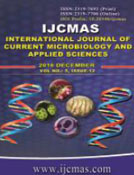


 National Academy of Agricultural Sciences (NAAS)
National Academy of Agricultural Sciences (NAAS)

|
PRINT ISSN : 2319-7692
Online ISSN : 2319-7706 Issues : 12 per year Publisher : Excellent Publishers Email : editorijcmas@gmail.com / submit@ijcmas.com Editor-in-chief: Dr.M.Prakash Index Copernicus ICV 2018: 95.39 NAAS RATING 2020: 5.38 |
To analyze Health care associated MRSA (HA-MRSA) and Community Acquired MRSA (CA-MRSA) strains and its risk factors. We studied the risk factors for HA-MRSA and CA-MRSA infections among patients of different wards at Navodaya Medical College, Raichur, from December 2013 to November 2014. Clinical isolates of Staphylococcus isolated from nose, axilla, groin, wounds, gastrostomy tubes, endotracheal tips and inguinal areas of the patients were confirmed as Staphylococcus aureus by tube coagulase test and Methicillin resistance was detected by oxacillin broth dilution method as per CLSI guidelines. Antibiotic susceptibility profile of the community acquired and hospital acquired MRSA against a set of antibiotics was detected by Kirby bauer method. 121 strains of MRSA (24.2%) were isolated. 91 (75%) were HA-MRSA and 30 (25%) were CA-MRSA strains. Highest numbers of HA-MRSA and CA-MRSA isolates were from nose. Significant correlation (P < 0.05) was observed between the types of MRSA, different wards, sites, and lengths of hospital stay. Antibiotic resistance rate was less in CA MRSA compared with HA MRSA isolates. 100% susceptibility to Linezolid, quinupristin/dalfopristin, tigecycline, tetracycline and cotrimoxazole was seen in all isolates of MRSA. Bacteriological confirmation of Staphylococcus aureus, MRSA and antibiotic susceptibility is very essential in the management of community acquired and hospital acquired staphylococcal infections.
 |
 |
 |
 |
 |